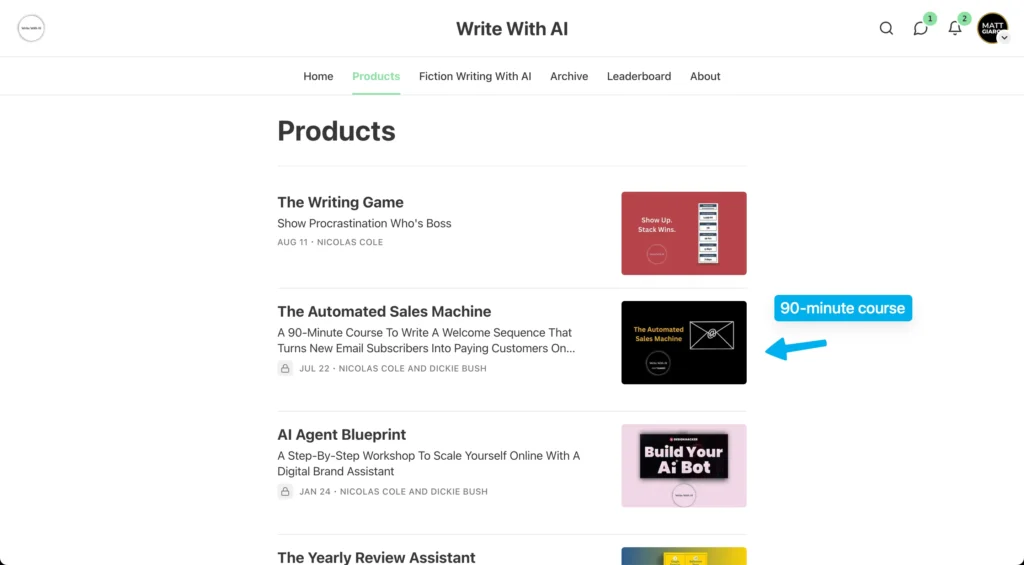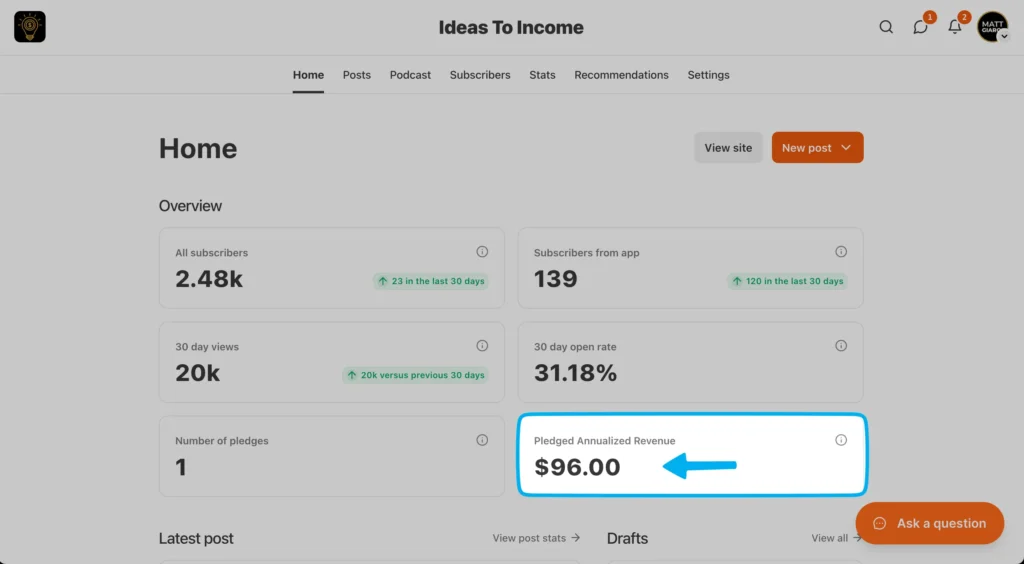Starting a paid newsletter looks thick on paper:
You imagine people sending you money every month to read your cute words while sinking into your hammock, feeling the sand between your toes.
But that’s not how it plays out in real life.
For every creator making a living off paid subscriptions, there are hundreds grinding away just to pay their bills.
Here are the ugly reasons why:
Newsletters are rubber bands
You can only pull it so tight before it snaps back in your pretty face.
There’s a secret limit to how much people are willing to pay for a newsletter before they feel it’s overpriced and snub your offer.
Take Ben Settle, a well-known email marketing industry leader.
He has a paid physical newsletter. It goes out once per month. It’s around 20 pages. He charges $97 for it.
Or take Jim Rickards, an expert in the financial industry. He has a newsletter called Strategic Intelligence that he sells for $25 a month. His newsletter goes out once per month, too.
On the lower spectrum, you have newsletters on Substack that charge 5 or 8 bucks per month.
Another example is Write with AI on Substack, which charges $20 per month for sending eight paid emails per month.
Like it or not, there’s a thick mental wall around how much you can charge for a newsletter.
If you want to monetize your expertise and content, is a newsletter really your best shot?
If $50 is probably the max you can charge before it all blows up, it’s time to ask this question:
How can I take the same content I’d put in a newsletter and create something else out of it?
Take, for example, an online course.
Courses sell for anywhere from $5 to $5,000.
Which means you have a thousand times more price elasticity to play with.
You can also take what you teach in the course and help people implement that as part of a coaching or mentoring offer.
That’s exactly what I do. I charge a grand per month for that.
Or you can take it to the next level and offer it as a done-for-you service where you can charge $5,000 to $10,000 per month.
Same content, different format.
One of my mentors used to say: “Great marketing doesn’t fix bad math.” And he’s right.
But most people don’t talk about this. Only a fraction of people will buy a monthly newsletter.
For example, when you’re launching an online course, if you do things well, 5% of your list will buy the course.
Extrapolate that to newsletters and do the math.
Got it?
Baksheesh your subscribers
Humans are corruptible.
In my 20 years of living abroad, I’ve seen many greedy clerks asking for baksheesh to speed up (read: not artificially slow down) my paperwork.
Bribing is also common practice in online marketing.
Only that marketers do it in a (perhaps) more ethical way.
You bribe people all the time: You add bonuses to your offers. You create lead magnets so that people join your list. You bribe people to read your articles with attention-grabbing headlines.
In short: You dress up your stuff in an elegant red cocktail dress.
And when it comes to your paid newsletter, it’s the same thing: You need to sweeten the deal with a little incentive.
Last August, I collaborated with Nicolas Cole’s Write with AI Substack. Their goal was to increase their paid newsletter subscribers. They reached out, and we partnered up.
I created a $150 workshop that their members could get for free in exchange for their $20 per month membership.

If you look at their members’ area, you’ll see they offer standalone workshops like the one I’ve created for them. These are online courses priced somewhere around $150 that people get when they join the newsletter.
It’s a bribe to get people in.
The newsletter alone is not enticing enough to get the sub. So when you think about it… It’s not just about writing emails.
Subscriptions are killing your profits
I don’t know about you, but I hate subscriptions.
Most of them don’t make sense. I rather prefer something one time than being a monthly milking cow.
Some subscriptions make sense, though:
- A coaching subscription makes sense because people want tailored feedback.
- A subscription to trade signals makes sense because markets change all the time.
It’s like your electricity or internet subscription — ongoing services you expect to get.
But what about “ongoing education”?
Do you think that people who want to become “more productive” are interested in learning about the Pomodoro technique for years to come?
In that case, doesn’t it make more sense to sell a product one time at ten times the price, say $200, rather than trying to sell a $20 subscription where people can bail each month?
Since most people hate subscriptions, you’ll have to slash prices to drag them in.
That’s a terrible incentive to me: I’m not a robot. Making money is a strong incentive in what I create.
With a small audience, I know that I can make way more money in a course that I can sell for $200 or $500 rather than typing out a newsletter that goes for $20.
10x difference.
You’ll make more money with this
Most creators have an audience problem.
When you’re just starting out and don’t have a large audience, you’ll get more leverage by putting things out for free rather than trying to monetize them right off the bat.
Many creators make this bloody mistake at the beginning.
They’re impatient grasshoppers and want to monetize their stuff straight away.
Getting a sale is though.
People procrastinate. They have to lift their butt off their comfy couch and grab their credit cards.
Thinking that you’ll make more money with low prices is stupid. Because it means more people to persuade. That’s why it’s easier to make more money with a higher-price product because you only have to convince a handful of souls. Not hundreds of them.
To illustrate this, let me show you this:

What you see above is a $96.00 pledge on my Substack account that I didn’t claim. (Thank you Michael — but I don’t believe in this business model.)
You and I can make 10x or 100x more on the back end by keeping my newsletter free rather than trying to monetize it for a few bucks a year (and making this subscriber feel scammed because he paid for something others can access for free).
This is the kind of strategic choice you need to make when doing business.
You’ll gain way more traction by keeping things free and then charging top dollar for your time, guiding people through your advice hands-on, rather than begging for loose change with a newsletter.
The hidden mental cost
Most people struggle to post a daily piece of content.
They have no clue how to come up with predictable ideas that their audience is interested in.
What they forget is that a membership model requires constant content creation. It’s like running on a treadmill.
And that treadmill is nastier than social media.
When people start paying for you to show up, your brain starts to function differently.
You tend to overthink. You need to make sure that what you’re offering is really something people are interested in. You have to cherry-pick exactly what 80% of your audience is interested in, or else you’re always sweating thinking about churn.
(Because churn is another metric most people don’t talk about.)
This adds more steam to the pressure cooker.
So unless you’re very well organized and have a clear content plan for the next 12 months, a paid newsletter is going to be a horror movie.
Okay, what’s next?
I’m not saying you can’t make money with paid newsletters.
I’m saying they are a terrible business model for small creators.
If you don’t have thousands of people on your email list consuming and loving your content, you’re shooting yourself in the foot by trying to create this kind of newsletter membership.
Most successful newsletters have other elements, like a community, and all this is extra work.
It’s not just about selling a newsletter subscription.
The game plan I suggest if you’re a small creator (less than 10k subs) is simple:
Create a lot of organic content. Get people onto your email list. And sell them more expensive stuff:
- Coaching
- Consulting
- Online courses
If you want to learn exactly how to do that, click here (and get my free bribe.)
